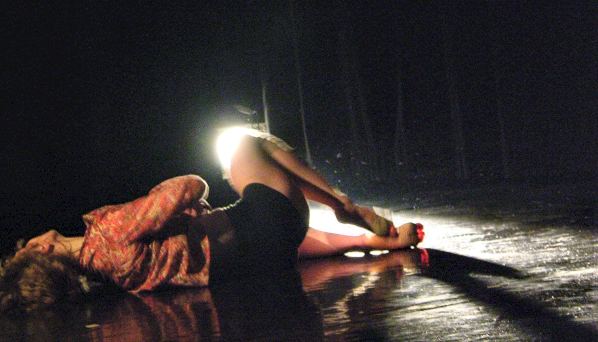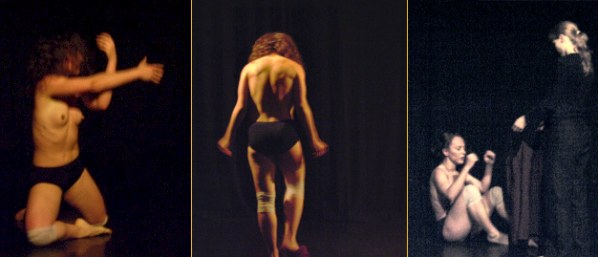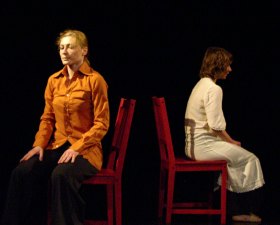Woman 2 Woman
Teresa Hackel, Constance Lüttich and Cynthia Gonzalez in choreographies of Hackel, Lüttich, Horta and Gonzalez
Website Cynthia Gonzalez
Dresden, 23 April 2006
This was intended to be my second report consisting solely of pictures, but in the process of selecting and processing photos I could not help writing comments.
Teresa Hackel: "Kleines Solo"

Hackel's short piece starts within a narrow illuminated rectangle. She crafts bizarre poses and exploits unusual movements like running waves through her belly while lying on the back. Invisible constraints limit her movement. Her muscles thrust against imaginary obstacles, her arms forcefully push against each other and against other parts of the body. A sharp arrow formed out of her stretched arms, caught on the photo above, is typical of Hackel's solos. In this one it seems to try to puncture an invisible barrier, or maybe it has something to do with the background which Hackel supplies: "Two parallels meet after centuries"? Knowing this, one might see the muscle strain as a struggle of the arms to come together, which remains futile during Hackel's slow passage within the rectangle. Suddenly all barriers disappear and she breaks free. The accumulated energy is released, driving her arms into dazzling circles and awarding the body with an awaited reprieve. I particularly enjoyed the "constrained" part with a number of unusual poses and contortions with muscles locked in tension.
Constance Lüttich: "Eiszeit"

Lüttich's choreography exploits the full scale of speed and space usage. There are passages of slow locomotion and others with the dancer running from one corner of the stage to the other as in a race, there are scenes with fast rolling and others with creeping on the floor.
In the last part the dancer crawls toward a single spotlight placed at the back of the stage (photo above). The spotlight is replaced by a single desk lamp, while she takes her dress off and positions her body as if attempting to collect the light by her skin. Teresa Hackel joins her, dressed in identical black pants and bra. She imitates Lüttich's movements, then she wraps her body in the dark fabric left in the corner and sits down on the chair, closing the life cycle.
Cynthia Gonzalez: Object Constant
Choreography Rui Horta
 An enraged macho opens the scene and attacks the dancer, trying to undress her. After a short fight he leaves her alone. The victim dances humiliation, anxiety and anger out of her soul. Because her dress is torn open, she holds it with one hand to cover her exposed breasts (photo right) or protects her chest from sight by an arm while dancing. The restriction obviously stands for the mental conditions of the abused woman who endured the assault rather than standing up to it. The limitation imposed upon her arms give her movement an interesting touch, while the movement itself is as precise, vibrant and emotionally compelling as we are used to from Gonzalez' previous performances. After a while, the audience starts to wonder how the story is going to be resolved. The answer is that the heroine eventually wins the fight against herself, abandons protection and all of a sudden faces the audience frontally with her arms dangling next to her hips. As she is slowly walking towards the audience, her face is devoid of anxiety, calm and self-confident. This was the most convincing use of (partial) nudity I have seen since Toula Limnaios' Double Sense.
An enraged macho opens the scene and attacks the dancer, trying to undress her. After a short fight he leaves her alone. The victim dances humiliation, anxiety and anger out of her soul. Because her dress is torn open, she holds it with one hand to cover her exposed breasts (photo right) or protects her chest from sight by an arm while dancing. The restriction obviously stands for the mental conditions of the abused woman who endured the assault rather than standing up to it. The limitation imposed upon her arms give her movement an interesting touch, while the movement itself is as precise, vibrant and emotionally compelling as we are used to from Gonzalez' previous performances. After a while, the audience starts to wonder how the story is going to be resolved. The answer is that the heroine eventually wins the fight against herself, abandons protection and all of a sudden faces the audience frontally with her arms dangling next to her hips. As she is slowly walking towards the audience, her face is devoid of anxiety, calm and self-confident. This was the most convincing use of (partial) nudity I have seen since Toula Limnaios' Double Sense.

Teresa Hackel emerges as a good fairy, bringing the lost dress to the dancer and a soothing end to the story.
Teresa Hackel and Constance Lüttich
in "Call No Call" by Cynthia Gonzalez

The last piece constituted the final exam of Gonzalez's master study in choreography. It is dance theater about interactions between two women, which take place on and around five red chairs. Different kinds of relationships from friendly to hostile are played in short scenes, formally connected by the use of chairs which serve to increase distance and create isolation. The choreographer focuses on the middle part of the friend-foe scale, limiting battles and avoiding passion. Chasing is playful rather than serious and a the only martial fight shown, with a kick above the head of the rival, takes just a couple of seconds. The focus is on taking notice, exploring potentials and waiting for a response.
 In the scene captured in the photo on the left side, both women try to avoid the first move but respond to a trigger immediately, which leads to a nervous tension and numerous "false alarms". Gabriele Gorgas wrote in Dresdner Neueste Nachrichten that the piece was not enough of a challenge for the dancers and she would prefer removing the chairs. As much as I respect her judgments, I disagree with her at this point. The primary focus in this piece is on the way how stirrings of the mind are distilled into movement, rather than on the novelty or esthetical appeal of the movement itself. The transformation of expectation, disturbance and misunderstanding in the interaction is what I found most interesting and innovative here. The chairs are an integral and necessary part of the story, because fundamental scenes like the one described and depicted above could not be achieved without them.
In the scene captured in the photo on the left side, both women try to avoid the first move but respond to a trigger immediately, which leads to a nervous tension and numerous "false alarms". Gabriele Gorgas wrote in Dresdner Neueste Nachrichten that the piece was not enough of a challenge for the dancers and she would prefer removing the chairs. As much as I respect her judgments, I disagree with her at this point. The primary focus in this piece is on the way how stirrings of the mind are distilled into movement, rather than on the novelty or esthetical appeal of the movement itself. The transformation of expectation, disturbance and misunderstanding in the interaction is what I found most interesting and innovative here. The chairs are an integral and necessary part of the story, because fundamental scenes like the one described and depicted above could not be achieved without them.

With this piece Cynthia Gonzalez accomplished her extended study of choreography ("Meisterklasse") in the Palucca School. Let's hope that we will continue enjoying her work in Dresden occasionally even though she is going to move to a new domicile soon.
Petr Karlovsky